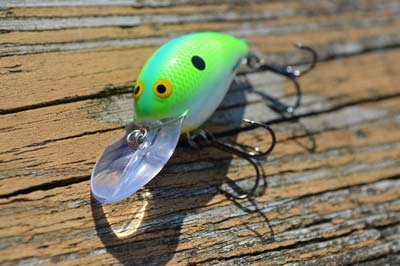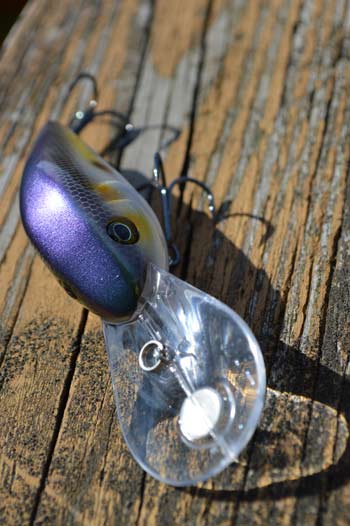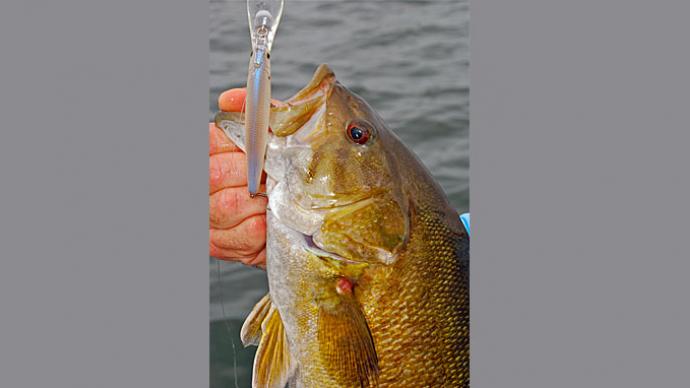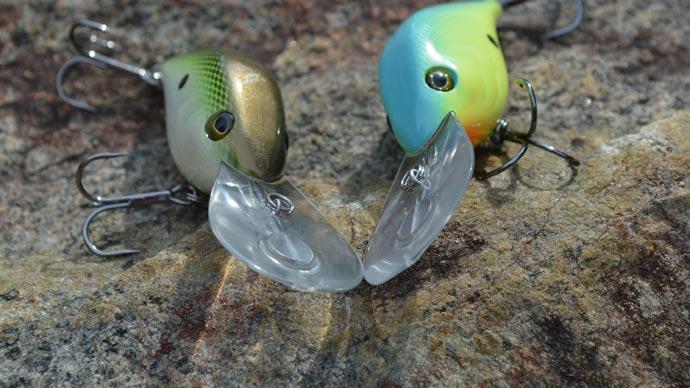
Bass anglers turn to crankbaits for many reasons. They quickly cover water and are available in a multitude of sizes, colors, and actions, making it easy to meet the needs of nearly any fishing situation. Crankbaits catch bass anywhere they swim and on any date on the calendar.
Within all that versatility, there is a time when crankbaits truly shine — post-spawn through summer. As each day in June passes, more and more bass finish spawning, vacating those shallow water spots and swimming toward summer haunts in deeper water. Along the way, they move along structure, such as points and creek channels, stopping to feed at key pieces of structure. It's rare to find them bunched up in one spot until they reach deeper water.
Keeping up with these bass requires some work. They’re on the move, so you need to be, too. And as their depth increases with time, you need different lures to reach them. And that lure is a crankbait.
But while picking up crankbaits is easy, don’t be lulled into their stereotype. Getting the most out of them requires more than casting and cranking. It takes knowledge, preparation, and planning to ensure you're fishing the right one at the right time. And while there isn't a hard and fast start or stop when you use a particular crankbait, you must move with most of the bass.
Not all bass make their move to summer haunts from spawning flats at the same time; conditions and other factors create more of a gradual shift. So, there's often overlap of when each crankbait style works best. But these five all play at some point, from Memorial Day to July 4, regardless of where you fish. They're all crucial ways to unlock early summer fishing success.
Square Bill
- Examples: Bill Lewis ATV Squarebill 1.5, Lucky Craft Skeet Reese SKT MR, Rapala Balsa Xtreme BX Mid Brat
- Key depth: 3 feet or shallower
- Key spots: Hard cover, including riprap, seawalls, stumps, laydowns, and dock posts
- Key retrieves: Speedy, bumping into as many pieces of cover as possible
While this crankbait hunts before bass are finished spawning, it has the best chance of catching you a trophy in the early days of post-spawn. It's then that bass still cling to the shallowest cover. It'll continue to produce during the shad spawn, a favorite feeding opportunity for bass, which happens when the water temperature approaches and passes the 70-degree mark.
Many early post-spawn and shad spawn spots are the same — riprap, dock posts, laydowns, and stumps. Retrieve your square bill so it contacts as many pieces of cover as possible. Those impacts attract bass and trigger them to strike. Let it pause — longer in cooler water, shorter in warmer water — after each impact. And take your time. The bill’s shape doesn’t allow it to roll over cover. Instead, it has to hammer its way through it. Pauses allow it to float up and over obstacles.
When to put it down: Once the shad spawn finishes and water temperatures climb, most bass will leave these shallow spots. While you still may catch a few on a square-bill crankbait, a deeper diving one will be needed to keep pace.
Shallow Diver
- Examples: Bandit 200, Bomber Model 5A, Googan Squad Recon
- Key depth: 3 feet to 5 feet
- Key spots: Isolated pieces of shallow water cover — laydowns, stumps, rocks, and clumps of aquatic vegetation — or shallow structure such as creek channels, ledges, and secondary points.
- Key retrieves: Grinding into the bottom with occasional pauses, especially after contacting cover or structure.
After bass bid adieu to the shallow cover where they spawned or feasted on shad, they move to slightly deeper water. They’re attracted to isolated pieces of cover, often a single stump or bit of brush just off shore and toward open water. The best ones are adjacent to structure such as a shallow creek channel or ledge.
While their profiles resemble a square bill, these crankbaits sport a different bill. It’s slightly longer, allowing it to reach greater depths, and rounded, allowing it to work through and around any cover it contacts. Often, simply slowing your retrieve at the first resistance of a snag is all it needs to wobble through. But before you start cranking after a cast, give your crankbait a couple of twitches across the surface. You'll be surprised how many bass come up to eat it.
When to put it down: Watch the local mayfly hatch. Its subsidence is a good barometer of when this crankbait is done and when it's time to pick up the next one.
Medium Diver
- Examples: Norman Deep Little N, Rapala DT10, 6th Sense Cloud 9 Series C10
- Key depths: 5 feet to 15 feet
- Key spots: Submerged cover near structure close to the main lake — drop-offs, channel-swing banks, points, sunken brush, rock, shell beds, and aquatic vegetation.
- Key retrieve: Steady with some speed, running it into cover and across structure.
With their longer lips and slightly larger bodies, these crankbaits are all about classic crankbaiting. Focus on spots away from shore; they're not technically offshore but aren't connected to the bank either. These are the last spots bass use before they settle into their summer haunts. In most bass waters, this crankbait begins to fire in mid-June. But don't lose sight of them entirely once July rolls around. You and the bass will return to them in about four to six weeks.
Your retrieve will be like what you used with a shallow diver. Cast length will be the only difference. The longer your cast, the deeper your crankbait will dive. So, cast well beyond your target, giving your lure enough running room to reach it.
When to put it down: Once they start producing, these crankbaits never truly go out of style. Even once they’ve set up shop on their deepest spots, some bass move slightly shallower and within range of a medium diver under the cover of a nighttime or overcast sky. And they’ll retreat to deeper water once the sun shines and pleasure boaters return.
Deep Diver
- Examples: Berkley Dredger 25.5, Norman DD22, Strike King 6XD
- Key depths: 15 feet to 30 feet.
- Key spots: Deep-water structure — humps, river channels, points — highlighted with stumps, brush, rocks, or other types of cover.
- Key retrieve: Slow grind with frequent pauses and collisions with cover and structure.
Image
Deep-diving crankbaits require a lot of work, from planning casting angles to cranking through plenty of resistance. But that work will pay off once summer’s heat arrives. Photo by Pete M. Anderson Your lure options are limited once bass have settled into summer spots. But one of the best of those few is a deep-diving crankbait. With a bill longer than its body, it can be cranked to upwards of 30 feet. There, you'll first search out structure — the more vertical, the better — then target cover, such as sunken brush, stumps, or rocks, that dot it.
Impacting cover or structure is as crucial in deep water as it was back in the shallows. Bass school on these spots, so when one impact triggers a bite, stay with it because more will follow. Catching and cranking with these all day is a full-body workout. They’re heavy, making them a chore to cast. And their big bills will fight you back to the boat. A long rod and low-geared reel will ease much of the work.
When to put it down: In many waters, especially reservoirs, most bass return to shallow water in mid- to late summer. At about that time, deep water becomes devoid of dissolved oxygen because of a lack of inflow and high temperatures. You can still catch them by switching back to your medium divers and associated spots.
Lipless
- Examples: Bill Lewis Rat-L-Trap, Booyah One Knocker, MegaBass Vibration-X Ultra
- Key depths: 1 foot to 30 feet
- Key spots: Shallow flats with isolated cover, submerged aquatic vegetation, submerged cover, and deep-water structure.
- Key retrieves: Fast and straight, pull and drop, rip and reel
Rig up a lipless crankbait on June 1, and don’t put it away. Depending on retrieve speed, and how long you’re willing to let it sink, these classic lures can be fished at any depth and around nearly any structure and cover. Buzz one across a shallow flat to catch early post-spawners just leaving their beds. Fish it over submerged aquatic vegetation later in June. Then, let it sink to the bottom on your favorite summer spots, fishing it with long pulls and short pauses.
Lipless crankbaits fill two roles during post-spawn and the early part of summer. First, they help you cover water quickly, searching for bass that are usually spread out. They are also terrific at creating reaction strikes. Their vibration and rattling sound turn even the most content bass into a biter.
When to put it down: Never — this crankbait can be fished in nearly any depth, with a variety of covers, structures, and different speeds. It'll work straight through summer.
Gear up

Choosing the right crankbait for when you're fishing is the first step. Next, you'll need the best gear to present it. And while it's the same for each of the crankbaits mentioned above, it differs from what's best for other lure styles. While none is required to catch bass with crankbaits, having some or all of it will increase efficiency, allowing you to cast accurately, properly present, and battle more bass into your boat.
Right rod
- Medium-heavy power: You'll need it to drive home hook sets and steer bass out of and away from cover. Don't hesitate to step up to a heavy power for deep divers.
- Moderate action: Regardless of power, the blank should flex from the tip to nearly the handle. It'll load easily, making you a casting distance master, and subdue feisty bass, ensuring trebles stay hooked.
Right reel
- Gear ratio: Slow it down, using 6.3:1 or less. That'll handle lipless crankbaits and shallow divers. You may want the leverage even lower gears provide to muscle long-billed medium- and deep-divers.
- Line capacity: Long casts, required for generating depth, need plenty of line. So, ensure your reel has enough and maybe a little extra. That’s an excellent insurance policy against fluffing a cast and having to cut some line to remove a backlash. We all do it from time to time.
Right line
- Pound test: Choose a smaller diameter the deeper you fish. A square-bill will work with 15- or 17-pound test. But to reach their maximum depth, medium and deep divers need thinner line, which has less water resistance, somewhere between 8- and 12-pound test.
- Material: Monofilament, which has a slight stretch, is the long-held standard for fishing crankbaits. Some anglers prefer fluorocarbon or braid, but you must be patient. They have less stretch, so wait slightly on hook sets and take your time with fights.
Colors
One characteristic shared by all crankbaits but not mentioned above is color. While it can play an essential role occasionally, it's best to stick to a few choices and concentrate on other variables dictated by seasonal movements, such as location and depth. Having crankbaits representing each of these color families will prepare you for nearly any day on the water.
- Baitfish: This can be shad in Southern waters or yellow perch up North. While realistic finishes are eye-catching, your baitfish imitator can be much simpler. The classic Smokey Joe — a combination of gray sides and black back — continues to put bass in boats.
- Crawfish: This combination of browns, greens and black isn’t only for fishing around rock. It’s a popular springtime pattern wherever submerged aquatic vegetation grows. Try variations that include chartreuse or orange when runoff makes shallow water dirty.
- Bright: Gaudy is the keyword for this one. Patterns include fire tiger, chartreuse shiner, and parrot. The potency of red lipless crankbaits, for example, was proven in east Texas fisheries, and now they're popular wherever wood, grass, and dirty water are found in spring.
BassResource may receive a portion of revenues if you make a purchase using a link above.




